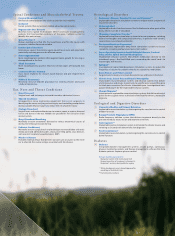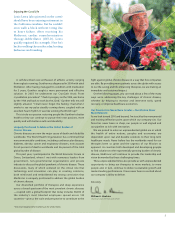Medtronic 2009 Annual Report Download - page 10
Download and view the complete annual report
Please find page 10 of the 2009 Medtronic annual report below. You can navigate through the pages in the report by either clicking on the pages listed below, or by using the keyword search tool below to find specific information within the annual report.
A key goal in managing chronic disease is to catch new
developments early. This allows doctors and patients to make
treatment or lifestyle changes before conditions worsen to the
point of needing more complex disease management.
Take heart failure, for example. It is the single most costly
medical expense in the United States, according to the American
Heart Association, and worsening heart failure can be difficult to
detect. “Heart failure symptoms, such as swollen feet or shortness
of breath, can be subtle,” said Dr. Roy Small, a cardiologist with
The Heart Group in Lancaster, Pennsylvania. “The typical older
patient with multiple conditions may not recognize symptoms
until it’s too late and they have to be hospitalized.”
We developed OptiVol Fluid Status Monitoring to help doctors
identify patients at greater risk of worsening heart failure, so they
can better manage the disease. OptiVol is built into many of our
implantable cardiac devices that treat heart-pumping and heart-
rhythm issues related to heart failure. OptiVol monitors for the
telltale sign of worsening heart failure: fluid build-up in the chest
area. While cardiologists have other ways to assess a heart failure
patient’s condition, like chest X-rays or blood tests, “Medtronic’s
OptiVol helps clarify the picture,” said Dr. Small. “If a patient
crossed the (fluid) threshold, we can work with them to adjust
diet and medications to get them back on track. Our practice
considers thoracic fluid level a vital sign for heart failure patients,
so we download and review a patient’s OptiVol report at every
visit,” he said.
After monitoring more than 800 patients using OptiVol,
Dr. Small sees another benefit of the technology: “It helps patients
comply with their management routine, which often includes diet
adjustments and medication. When one of my patients crossed
the fluid threshold on a weekend, I asked him what happened. He
didn’t know, but his wife jumped in and said they were out of town
at a wedding and he forgot to take his pills. Now that the patient
knows his device is that smart, he’s taking better care of himself.”
In 2009, the Centers for Medicare and Medicaid Services—a key
payor in the United States—began covering physician time spent
analyzing heart failure patients’ fluid trend data from our
implantable cardiac devices.
Monitor and Intervene Early
200
160
120
80
40
0
OptiVol Fluid Index
Fluid
OptiVol
reshold
Dec Feb Apr Jun Aug
b
How OptiVol Works
OptiVol Fluid Status Monitoring uses low-level electrical
pulses that travel across the thoracic cavity (the chest area
encompassing the lungs and heart) to measure resistance
levels. Decreased resistance indicates fluid in the chest
area—a common sign of heart failure. Healthcare
professionals download the data, which is delivered via
easy-to-read reports, including the one shown above that
plots fluid levels against a recognized threshold.
6























